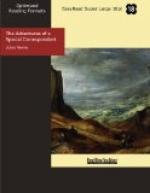I repeat, the country is not particularly varied. The ground is nearly flat in the sandy districts, and quite flat in the alluvial plains, where the brackish water stagnates in pools. Nothing could be better for a line of railway. There are no cuttings, no embankments, no viaducts, no works of art—to use a term dear to engineers, very “dear,” I should say. Here and there are a few wooden bridges from two hundred to three hundred feet long. Under such circumstances the cost per kilometre of the Transcaspian did not exceed seventy-five thousand francs.
The monotony of the journey would only be broken on the vast oases of Merv, Bokhara and Samarkand.
But let us busy ourselves with the passengers, as we can do all the more easily from our being able to walk from one end to the other of the train. With a little imagination we can make ourselves believe we are in a sort of traveling village, and I am just going to take a run down main street.
Remember that the engine and tender are followed by the van at the angle of which is placed the mysterious case, and that Popof’s compartment is in the left-hand corner of the platform of the first car.
Inside this car I notice a few Sarthes of tall figure and haughty face, draped in their long robes of bright colors, from beneath which appear the braided leather boots. They have splendid eyes, a superb beard, arched nose, and you would take them for real lords, provided we ignore the word Sarthe, which means a pedlar, and these were going evidently to Tachkend, where these pedlars swarm.
In this car the two Chinese have taken their places, opposite each other. The young Celestial looks out of window. The old one—Ta-lao-ye, that is to say, a person well advanced in years—is incessantly turning over the pages of his book. This volume, a small 32mo, looks like our Annuaire du Bureau des Longitudes, and is covered in plush, like a breviary, and when it is shut its covers are kept in place by an elastic band. What astonishes me is that the proprietor of this little book does not seem to read it from right to left. Is it not written in Chinese characters? We must see into this!




